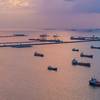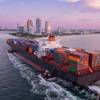In the current evaluation of all port state inspections of ships during the past year within the scope of the "Paris Memorandum of Understanding" (Paris MoU) of the European Port State Control, Germanischer Lloyd took first place, as in the previous years.
The Paris MoU determined the number of class-related detentions for each classification society and expressed them in relation to the total number of port state inspections during the years 2003 to 2005. For Germanischer Lloyd, only 43 detentions were noted for a total of 11,882 inspections. This yields a calculation factor of -1.57, which is the lowest value for the 25 societies considered.
Port State Control is based on an agreement of the maritime transport authorities of Northwestern Europe dating back to January 26, 1982. It is aimed at achieving greater effectiveness in the enforcement of international conventions, and provides for the annual inspection of at least 25 percent of all ships calling at European ports. The ships are selected according to the criteria of the Paris Memorandum of Understanding and the European PSC Directive. All ships to be examined are subjected to at least an "initial inspection" in accordance with the applicable provisions. This includes a check of all certificates and documents of the ship and its crew as well as a general condition assessment of the vessel. A "more detailed inspection" is performed if, during the initial inspection, there were clear grounds to believe that the requirements of the relevant international conventions have possibly not been met. In the event of serious deficiencies, the ship may be detained until these shortcomings are rectified.
The provisions of the Paris Memorandum of Understanding were tightened after the sinking of the tanker Prestige. Since 2003, oil tankers over 3,000 GT and older than 15 years; gas tankers older than 10 years; chemical tankers older than 10 years; bulk carriers older than 12 years; and passenger ships older than 15 years are subjected to a "mandatory expanded inspection", if the previous expanded inspection took place more than 12 months ago. The scope of inspection of these high-risk vessels is specified in detail. All ships exhibiting a target factor of over 50 are now subjected to a mandatory inspection.
Subscribe for
Maritime Reporter E-News
Maritime Reporter E-News is the maritime industry's largest circulation and most authoritative ENews Service, delivered to your Email five times per week










